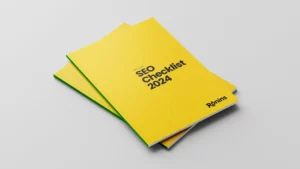
Bad Websites: 5 Common Design Fails and How to Fix Them
Table of Contents
TLDR
The article “Bad Websites: 5 Common Web Design Fails and How to Fix Them” outlines frequent mistakes in web design and offers solutions to improve user experience.
Key issues include poor navigation, slow loading times, lack of mobile optimisation, flawed content discovery paths, and improper use of colour and contrast.
Solutions involve streamlining site structure, optimizing images, adopting responsive design, enhancing content discovery, and following WCAG guidelines for colour contrast.
By addressing these problems, website owners can enhance usability, increase engagement, and improve accessibility, creating a more effective and user-friendly online presence.
Introduction – What Makes a Website Bad?
As web designers with decades of experience in the digital marketing industry, we’ve repeatedly encountered the following common bad web design practices. Web design trends come and go, but thankfully, design principles rarely do. We’ll navigate you through these pitfalls and, more importantly, provide solutions to correct them. Although we’ve thrown in a couple of bad website examples, this isn’t about pointing fingers; it’s about turning those oh-no moments into ah-ha ones.
Whether you’re a seasoned web designer, a small business owner looking to make your mark, or just curious about what makes a website tick, this article is your common sense guide to avoid common mistakes seen in bad websites and to help create sites that look beautiful and work effectively.

Bad Websites – Design Fail #1:
Poor Navigation
Ever landed on a poor-quality website and felt like you were dropped in the middle of a maze without a map? That’s poor navigation for you, and it’s a common trait of bad websites. Users come to your site with a goal in mind, and if finding their way around feels like solving The Da Vinci Code, they’ll leave. Fast.
The Website Design Issue
Navigation is the backbone of usability. When it’s complicated, hidden, or non-intuitive, it spells trouble. Maybe your menu items are vague, the layout is confusing, or essential links are buried in the footer. These are the breadcrumbs that lead nowhere, leaving users frustrated and your bounce rate high.
Bad Website Fallout
What’s at stake? Well, a lot. First off, user satisfaction plummets. Visitors who can’t navigate your site easily won’t stick around to see what you offer, no matter how great it is. Poorly designed navigation leads to increased bounce rates, which can negatively affect your SEO rankings. Search engines love user-friendly sites, and a site users flee from is a red flag.
Navigating to Solutions
Chart the course towards clearer, more intuitive navigation for your next website project:
- Streamline Your Site Structure: Think of your website as a book. It needs a clear table of contents (menu) and well-defined chapters (sections). Each page should have a clear purpose and be easily accessible from anywhere on the site.
- Descriptive Labels: Use menu labels that instantly tell users what they’ll find on that web page. Avoid jargon or creative titles that might confuse more than they clarify.
- Sticky Navigation: Consider a sticky menu that scrolls with the user. It’s always accessible, no matter where your visitor is on the web page. This is especially handy for long-scrolling sites.
- Simplify Navigation: Less is often more. A mega menu might seem like a great idea, but if users need a compass to navigate your options, it’s time to pare back. Avoid cluttered layouts with distracting elements and focus on your most important web pages.
- Search Functionality: For larger sites, a search bar is a lifeline. A search feature allows users to bypass the hunt through menus and go straight to what they’re looking for.
- Mobile Matters: With over half of web traffic coming from mobile, your navigation must be touch-friendly. Drop-down menus that work with a hover on desktop need a click alternative on mobile.
Web Design Takeaway #1
Improving your site’s navigation isn’t just about aesthetics; it’s about creating a smooth, enjoyable experience for your visitors. Making these adjustments keeps potential frustration at bay and paves the way for better engagement, lower bounce rates, and, ultimately, a more successful online presence. The best path is always the one that’s easiest to follow.
• • •
Bad Websites – Design Fail #2:
Slow Loading Times
In a TikTok era where patience is as thin as your smartphone screen, slow-loading websites are the silent killers of the digital world. When you click on a new website, excited to see what it offers, but instead get a loading screen that seems to last a lifetime. For the worst websites, it’s the equivalent of waiting in line at the supermarket with only one till open. The result? Frustration levels rise, and before you know it, you’ve clicked away, possibly never to return.
The Website Design Issue
A website with a slow loading speed is a major turn-off. Large, unoptimised images, clunky scripts, and server latency can bog down your site’s speed. Even a few extra seconds can feel like an eternity, costing you valuable traffic and conversions.
Bad Website Fallout
Slow loading times don’t just irritate your visitors; they also hurt your site’s SEO. Search engines prioritise user experience, and a sluggish site ranks lower in search results. This means less visibility for your site and fewer opportunities to engage with potential customers or readers.
Shifting Gears: How to Accelerate Your Site
Let’s put the pedal to the metal and speed things up with some effective fixes:
- Optimise Images: Large images, particularly background images, are one of the main culprits behind slow-loading pages. Compress and optimise your images for the web without sacrificing quality. Tools like Photoshop or free online services like TinyPNG can significantly reduce file sizes without generating low-quality images.
- Minimise HTTP Requests: Each piece of your site (scripts, images, stylesheets) requires a separate HTTP request to load. Reduce these requests by simplifying your site design and combining files where possible.
- Use a Content Delivery Network (CDN): CDNs distribute your website’s content across multiple, geographically diverse servers, reducing the distance it needs to travel to reach your user, which in turn speeds up load times.
- Leverage Browser Caching: Caching stores parts of your site on the user’s browser, so on subsequent visits, pages load much faster. Ensure your server settings are optimised to make the most of caching.
- Evaluate Your Hosting: Sometimes, the problem lies with your web hosting service. If your site has outgrown its current hosting plan, consider upgrading to a more robust option that can handle your traffic and content needs.
Web Design Takeaway #2
A fast-loading website is non-negotiable in the digital age. By addressing the common culprits of slow performance, you not only enhance user experience but also improve your site’s SEO, leading to better visibility and engagement. In the race for online attention, speed is your greatest ally. Don’t let a sluggish website be the reason you’re left behind.
• • •

Bad Websites – Design Fail #3:
Not Mobile-Friendly
It’s a simple truth: if your site isn’t optimised for mobile, you’re not just losing visitors but also saying a big “no thanks” to potential business. In a world where over half of all web traffic comes through mobile devices, having a site that shines on the small screen isn’t just nice to have; it’s essential.
The Website Design Issue
A poorly designed site that’s not mobile-friendly is a site that’s stuck in the past. Pinching to zoom, endless scrolling to find a navigation button, or text that’s so tiny it could be mistaken for fine print are all signs of a website that’s not ready for the mobile era. These issues don’t just create a poor user experience; they actively push your audience away.
Bad Website Fallout
Beyond frustrating your mobile website visitors, a lack of mobile optimisation can severely dent your site’s search engine rankings. Google and other search engines prioritise mobile-friendly websites in their search results, recognising the shift towards mobile browsing. If your site isn’t up to par, it’s likely to end up buried beneath those that are.
Embracing Mobile: The Path to Optimisation
Here’s how you can ensure your website is ready to meet the mobile demand:
- Adopt Responsive Web Design: This is non-negotiable. Implement responsive design using media queries to allow your website to automatically adjust to fit the screen it’s being viewed on, providing an optimal experience across all devices. It’s about giving everyone the best seat in the house, no matter where they’re sitting.
- Simplify Your Web Design: Avoid cluttered websites that overwhelm users with too many design elements. On a smaller screen, less is definitely more. Simplify your site’s design to improve readability and ease of navigation on mobile devices. Think white space, large, easily clickable buttons, streamlined menus, and content that gets straight to the point.
- Test Across Devices and Browsers: What works on one device or browser might not work on another. Regularly test your site across different devices and browsers to ensure a consistent and seamless user experience. Tools like Google’s Mobile-Friendly Test can provide insights and recommendations for improvements.
- Optimise Load Times: Speed is even more critical on mobile. Follow the strategies outlined in the section on slow loading times to ensure your mobile site is as swift as it is sleek.
- Touch-Friendly Design: Ensure all buttons, links, and navigational elements are touch-friendly. This means making them large enough to be easily tapped with a finger without the risk of selecting the wrong link.
Web Design Takeaway #3
Making your website design mobile-friendly is about opening your digital doors to the widest possible audience. In our mobile-first world, a site that’s accessible, responsive, and fast on mobile devices isn’t just an advantage—it’s a necessity. By optimising for mobile, you’re showing your users that you value their experience, no matter how they choose to connect with you.
• • •
Bad Websites – Design Fail #4:
Poor Content Discovery Paths
Imagine walking into a library, but there are no signs, the books are in disarray, and the librarian is nowhere to be found. That’s the online equivalent of a poorly designed website with flawed content discovery paths. It’s a place where valuable content exists but is hidden in a labyrinth of poor design and navigation choices. Your content needs to be easily found by users. If it’s hidden or hard to access, it might as well not exist.
The Website Design Issue
Content is king, but even a king can go unnoticed without the right pathways to discovery. When users struggle to find the content they’re interested in due to unclear categorisation, ineffective search functionalities, or a lack of intuitive navigation cues, their engagement drops. This isn’t just a missed opportunity; it’s a direct invitation for them to leave your site in search of someone else who gets it right.
Bad Website Fallout
A bad website design that makes it hard for users to find what they’re looking for undermines its own purpose. This not only affects user engagement and satisfaction but can also have a ripple effect on your site’s SEO performance and bounce rates. High-quality, relevant content is crucial for keeping users interested and encouraging them to explore further, but if they can’t find it, those benefits are lost.
Charting a Better User Journey: Enhancing Content Discovery
Let’s clear the path and make it easy for your audience to discover the treasure trove of content you offer:
- Content Recommendations: Improve user flow by utilising algorithms or curated selections to recommend related content to your visitors. This could be at the end of articles, in sidebars, or through “you might also like” suggestions, encouraging deeper engagement with your site.
- Highlight Popular or Recent Content: Dedicate areas of your site to showcase trending or the latest content. This not only aids discovery but also signals to users that your site is active and up-to-date.
- Use Visual Cues and Content Previews: Engage users with visual cues like thumbnails or preview snippets that give insight into the content before they click. This visual engagement can pique interest and guide users towards content they might enjoy.
- Accessibility and User Feedback: Ensure your content discovery features are accessible to all users, including those with disabilities. Additionally, consider incorporating user feedback mechanisms to continually refine and improve the discovery process.
Web Design Takeaway #4
The journey to your content should be as compelling as the content itself. Enhancing content discovery paths on your website makes it easier for users to find what they’re looking for and creates a more engaging, dynamic, and satisfying user experience. A good website where content shines bright is a website that keeps users coming back for more.
• • •

Bad Websites – Design Fail #5:
Poor Use of Colour and Contrast
The power of colour in web design goes beyond aesthetics; it’s a critical tool for creating clarity and emphasis and guiding user behaviour. When misused, it can lead to confusion, strain, and a swift exit. A well-designed website uses colour and contrast not just to catch the eye but also to enhance usability and ensure content is accessible to everyone.
The Website Design Issue
Poor or excessive use of colour and contrast is a design failure that will negatively affect user experience – making text hard to read, visual elements difficult to distinguish, and actions unclear. This isn’t just a problem for internet users with visual impairments; it affects a wide range of visitors who may find navigating the site more challenging than it should be. Subtle colour differences that look chic to some may render text virtually invisible to others, particularly those with colour vision deficiencies.
Bad Website Fallout
Poor web design that neglects colour contrast and readability can significantly impact user engagement and accessibility. It risks alienating users who struggle with vision impairments, reducing the overall effectiveness of your website. Moreover, it can harm your site’s SEO, as search engines increasingly prioritise accessibility and user experience in their ranking algorithms.

Enhancing Usability Through Color and Contrast
Let’s brighten the outlook with some actionable steps to use colour and contrast effectively:
- Adhere to WCAG Guidelines: The Web Content Accessibility Guidelines (WCAG) outline recommended contrast ratios for text and background colours. Aim for a minimum contrast ratio of 4.5:1 for normal text and 3:1 for large text.
- Use Tools for Testing Contrast: Numerous online tools can help you test colour contrast against accessibility standards. Leveraging these can ensure your choices are aesthetically pleasing and accessible.
- Consider Colour Blindness: Design with colour blindness in mind by avoiding colour combinations that are commonly problematic, such as red/green. Tools and simulators can show you how your colour choices appear to those with different types of colour vision deficiencies.
- Use Colour Purposefully: Colour should do more than decorate; it should communicate. Use colour to highlight important actions, like button states (normal, hover, active), and to differentiate design elements, such as links within text.
- Ensure Text is Readable: Beyond contrast, consider font styles, font size, spacing, and background textures. Even with the right contrast ratios, small, tightly packed text on a busy background can be difficult to read, so use plenty of white space. Avoid using too many different fonts.
- Provide Alternatives: When using colour to convey information (like status indicators), also include text labels or icons so that information is accessible to those who cannot distinguish the colours used.
Web Design Takeaway #5
The thoughtful use of colour and contrast is not just a design choice or good intentions; it’s a nod to inclusivity and user-friendliness. Prioritising these design elements ensures your website is visually appealing, accessible and easy to navigate for a broader audience. The goal is to create a user-friendly website that welcomes all users with open arms, where content shines and barriers to access are dissolved by design.
• • •
Making your website world-class
Common mistakes that make bad websites can significantly hinder user experience and site effectiveness. However, straightforward solutions exist for each of these problems.
By addressing the challenges of badly designed websites, website owners can enhance usability, boost engagement, and improve accessibility, making their sites more appealing and functional for a wider audience. The key to success in web design lies in focusing on user needs and continuously testing and refining the site based on feedback and best practices.
Adopting these strategies avoids common pitfalls of bad website designs and lays the foundation for a positive and inclusive user-friendly experience. This approach ensures that websites avoid design mistakes and serve their primary purpose effectively: to connect with and engage users by providing them with value and ease of use.
Whether you’re creating a single-page website, landing page or global presence, meeting and exceeding user expectations epitomises what makes a good website stand out from the bad.





